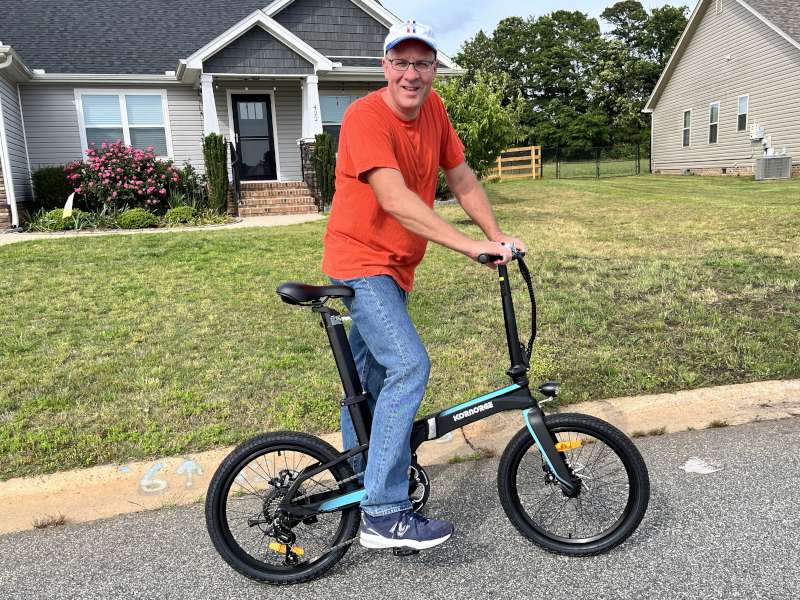
REVIEW – We live in an area that’s pretty rural, but our son lives in a major city. He’s looking for an ebike that makes it easier for him to ride to all those shops that are too far to walk yet too close to drive. As he lives in an apartment on the third floor, he needs a bike that is fairly light and can fold up into a smaller space. I’m hoping that the A9 from Kornorge is the right bike for him.
What is it?
The Kornorge A9 is an urban ebike wih a range of 25 miles and a max speed of 15 MPH. It weighs 41 pounds and can fold in two places. Kornorge is a brand established in 2021 to “provide consumers with an unparalleled customer experience, to meet people’s needs and lifestyles of green mobility [sic], to strictly control the quality of our products, and to put product safety as our top priority.”
What’s in the box?
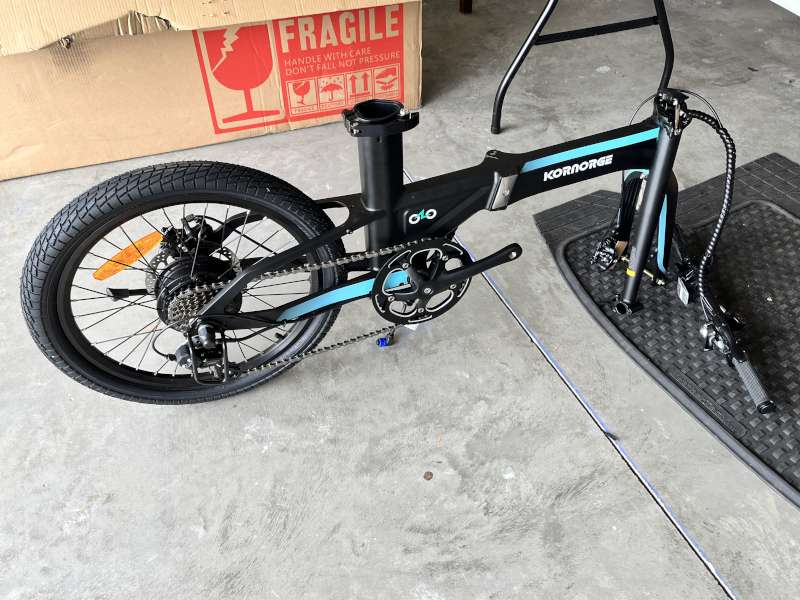
- The bike with handlebars connected via cabling
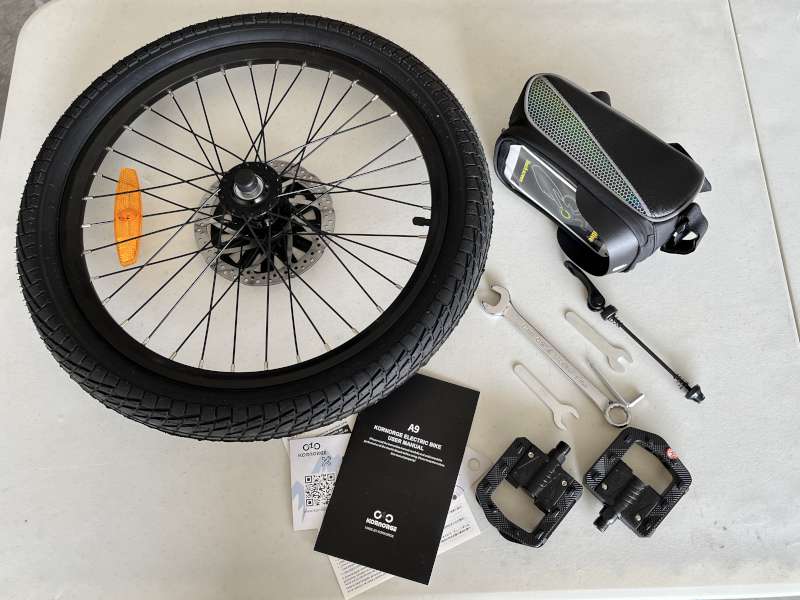
- Front wheel and its quick release lock
- Two pedals
- Four wrenches
- Small saddle bag
- Manual and warranty card
Specifications
- Motor: 250 W
- Battery: Lithium-ion
- Range: 25 miles
- Top speed: 15 MPH
- Weight: 41 pounds
- Max load: 264 pounds
- Dimensions: 27 inches tall x 50 inches long
- Tires: 20 inches
- Material: Magnesium alloy
- Display: speed, pedal assist, odometer
- Gear shifter: Shimano 7-speed
- Waterproof: IP54
Design and features
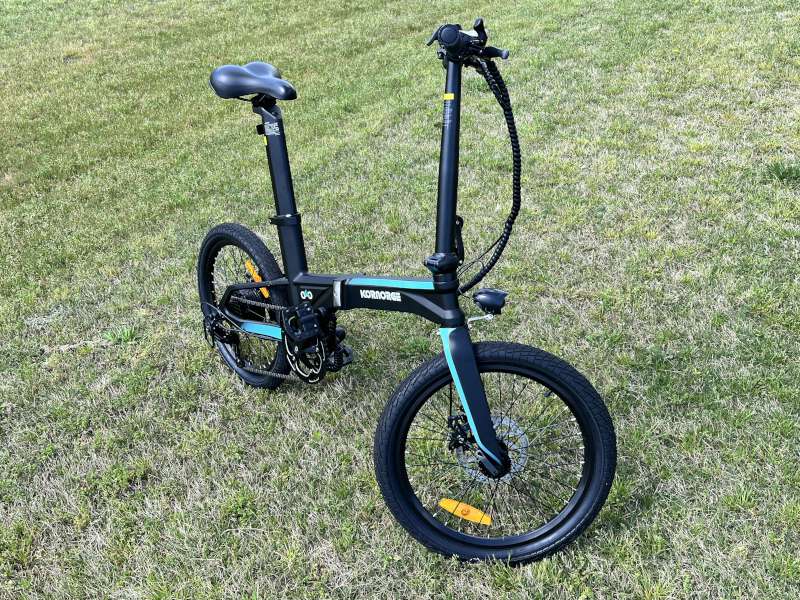
The A9, like other ebikes in this space, is the bike version of a Kia Soul, small and blocky, practical not flashy. The tires are small, the handle bar stem and seat tube jut out from the down tube at 90-degree angles, and everything looks extra compact. It’s a design intended for shorter rides in an urban setting.

I love the paint job on the Kornorge A9, a matte finish that’s very smooth. The logo looks sharp, the light blue strips complement the black paint, and there are very few places where I see the welding. Though a practical bike, it has a nice look.
Installation and setup

The Kornorge A9 electric bike arrived in a long, flat box. There were a few foam inserts and some cardboard wraps, and several parts were held together with cable ties. This provided some protection for the bike, but not enough. There were several nicks and scratches on the bike, especially on the handlebars. One was sharp enough that I had to file it down with a metal file to prevent me from getting cut on it. I would prefer Kornorge to use more foam inserts to better protect this gadget.
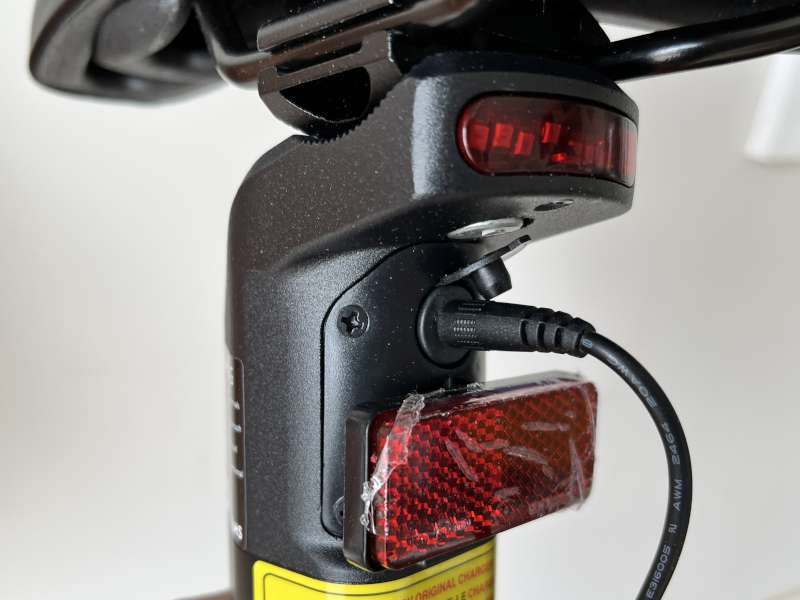
The first thing I did was to find the charger and the seat. On this bike, the battery is built into the seat tube and thus is connected to the seat itself. The manual says that it takes four to five hours to charge, which provides enough juice to bike for 25 miles. An LED on the charger is red when charging and green when finished.
Next, I read through the manual. Oh, my! This manual is a total disaster. The English is horrible, and some of the information is useless. (Why did Kornorge include a schematic of the circuits used to charge the battery? Are we electrical engineers?) The worst part, however, are the instructions for assembling the bike: There are literally only two sentences. One of those is a run-on, so maybe we give them credit for three sentences. For a gadget this complex, that means that there’s a lot of important information that is skipped. If you have experience assembling ebikes, this failed manual might not be a problem, as you may be able to figure things out. Most people, however, will want to pass on this bike and get one that is better documented. Kornorge needs to pitch this manual and start again.
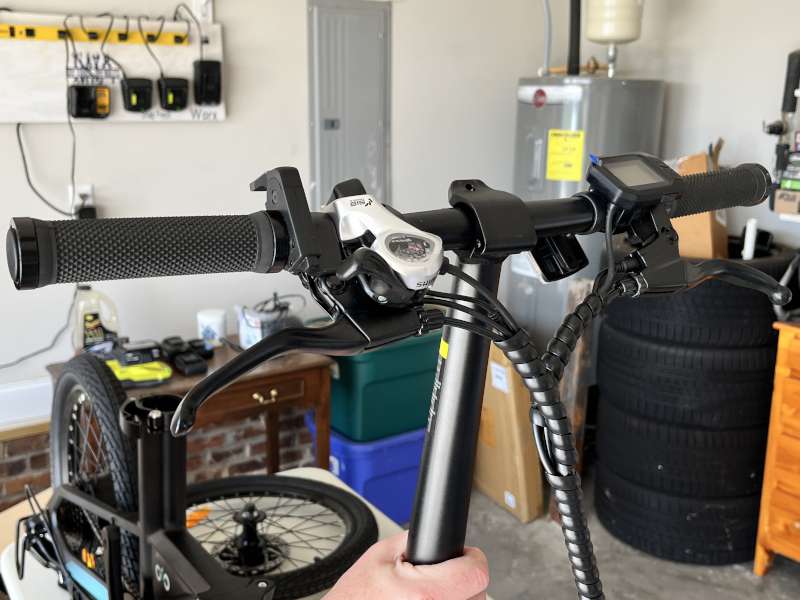
Thankfully, my friend Chris, an experienced biker, came over to give me a hand, and we were able to figure things out. We raised the handle bar stem to its upright position and locked it with a quick release. We put the handle bars into place on top of the stem.
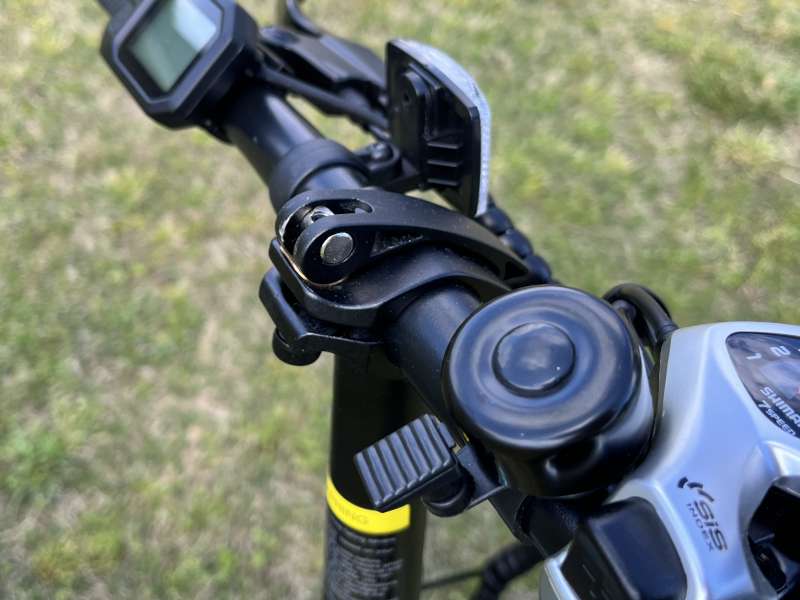
The bar is held in place with a screw and another quick release.
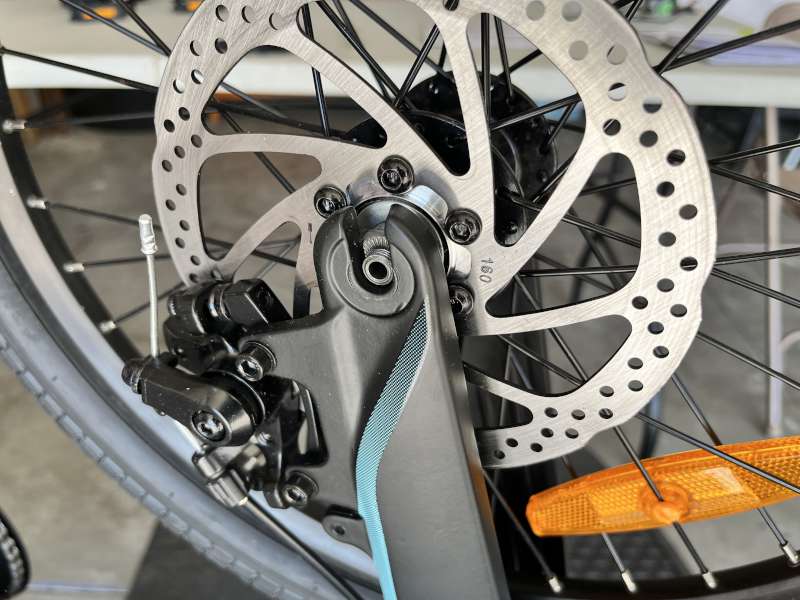
We turned the Kornorge A9 ebike upside down and dropped the front wheel into place, making sure the brake rotor slipped into the brakes.
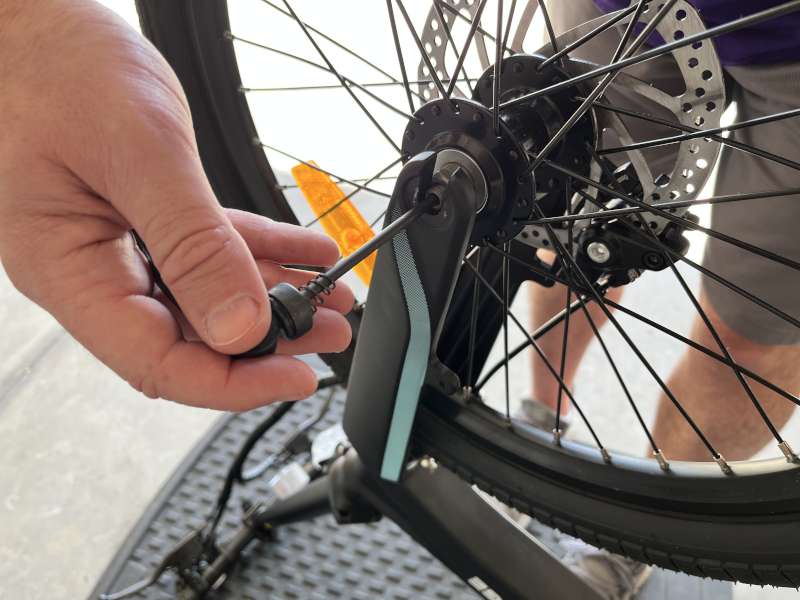
We slipped the wheel quick release through the axle and locked it. We pumped the brakes a few times to align them and then spun the wheels. Kornorge did a nice job aligning the wheels and the brakes. We turned the bike back over and tested the breaks; they were working great.
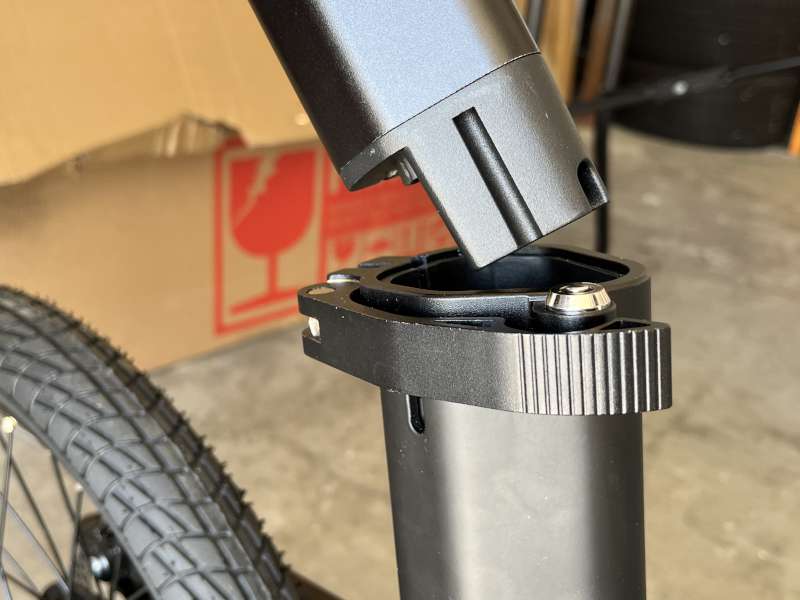
We slipped the battery tube down into the seat tube until it poked out the bottom.
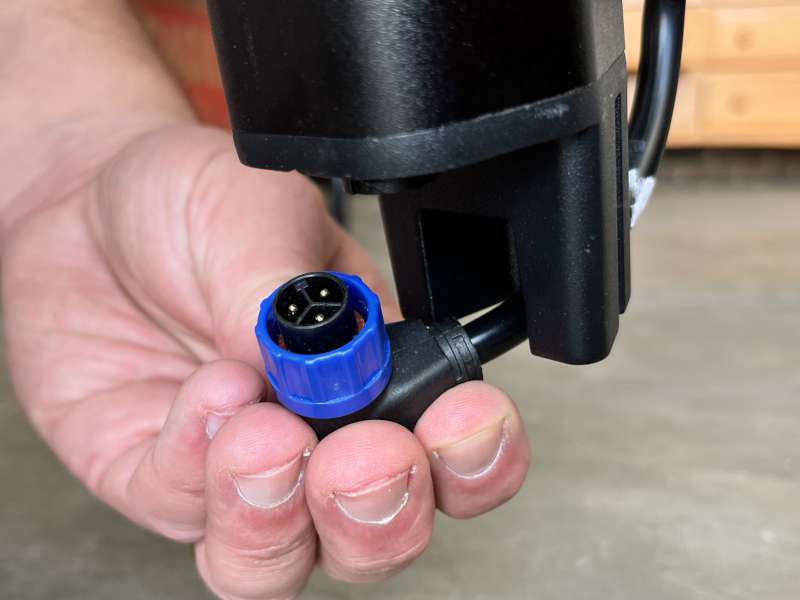
Yes, there’s a hole in the bottom of the seat tube, which is where we plugged in a cable into the bottom of the battery. I really don’t like this design. This plug is on the bottom of the bike, where it will get soaking wet every rainy day. The plug is rated as IP54 (protected against dust limited ingress and protected against water splashed from all directions), but eventually, the seal will fail and cause a problem. I wish the engineers at Kornorge had found a better way to provide power to the rest of the bike.
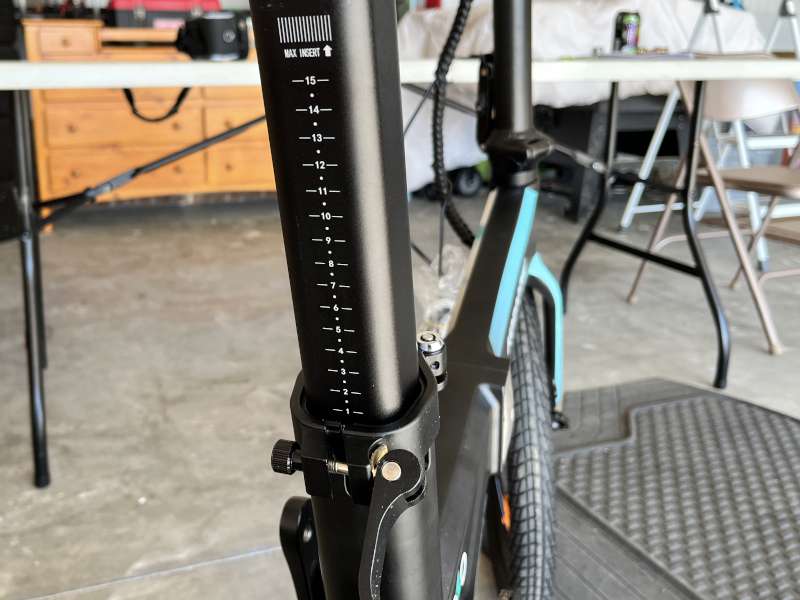
We raised up the battery tube to the maximum position within the seat tube. Kornorge clearly marked the battery tube with the min and max safe heights, and this is fantastic. It’s so easy to know where it can be adjusted and to remember the preferred setting. We then closed the quick release lever and locked the battery tube into place. There’s a lock on the quick release to prevent the seat from getting stolen and a pair of keys to unlock it.
In order to take the battery inside for charging, I will need to unlock it, pop the quick release, lower the seat, unplug the cable, and then slide the tube out. I will need to take the entire tube and the seat inside. This is not a very graceful solution—most ebikes have a way to pop out the battery without fooling with cables or the seat—but it will work.
The seat arrived positioned at a slightly awkward angle, so we removed the rear tail deflector and loosened a screw and nut under the seat. This allowed us to adjust the seat to a more comfortable position. Loosening the nut requires a 6mm Allen wrench, which did not come with the bike.
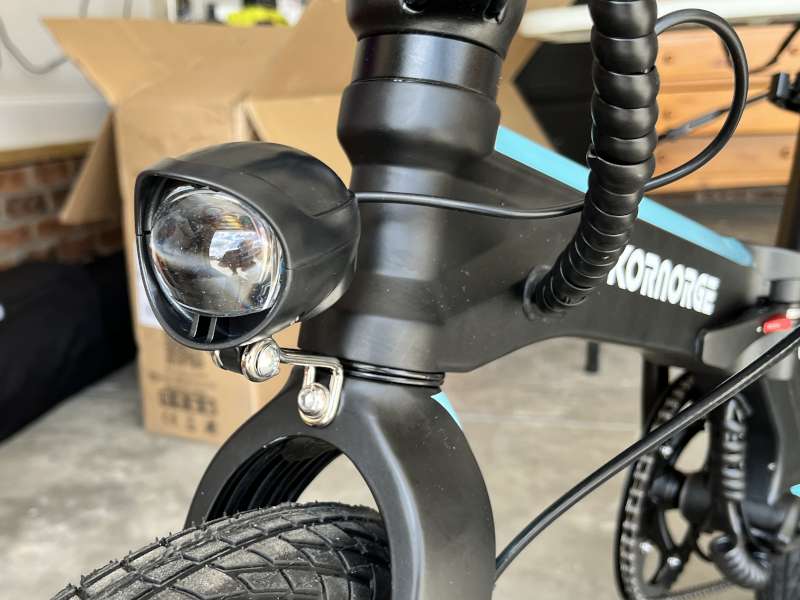
We installed the front light using the screwdriver on the Allen wrench (that was supplied) and an open wrench (that was not supplied). The taillight is built into the back of the seat tube, so we didn’t need to do anything for that.
It’s baffling to me how Kornorge included four wrenches, yet failed to supply all the tools necessary for this job. Even worse, once we were finished, we realized that we had used all the tools except for one; Kornorge included a nice wrench that doesn’t fit anything on the bike. Kornorge needs to pay attention to the process for assembling their bike, provide all the tools necessary, and stop including extra tools. Even better, they could design their bike so that it doesn’t need so many different types of tools to assemble it.
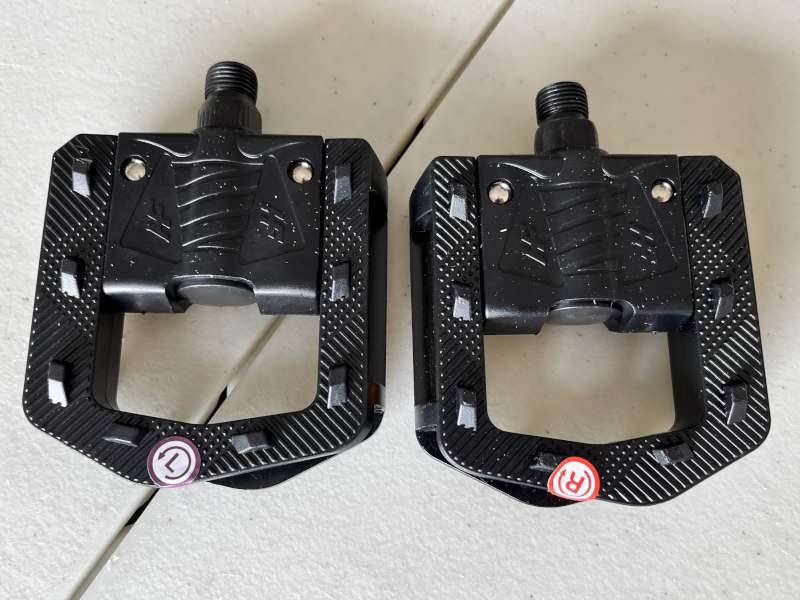
The pedals are a bit small and made of plastic, and they include little knobs to improve traction. These will work fine for urban riding.
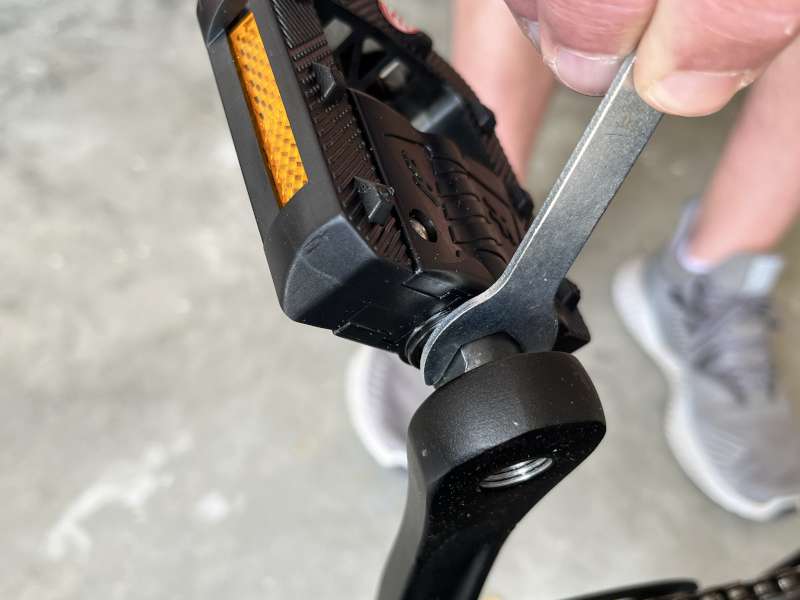
The pedals are clearly marked as left and right, so we tightened them using one of the included wrenches. The manual does have a picture on how to assemble the pedals, noting that one is tightened clockwise and the other “anticlockwise.”
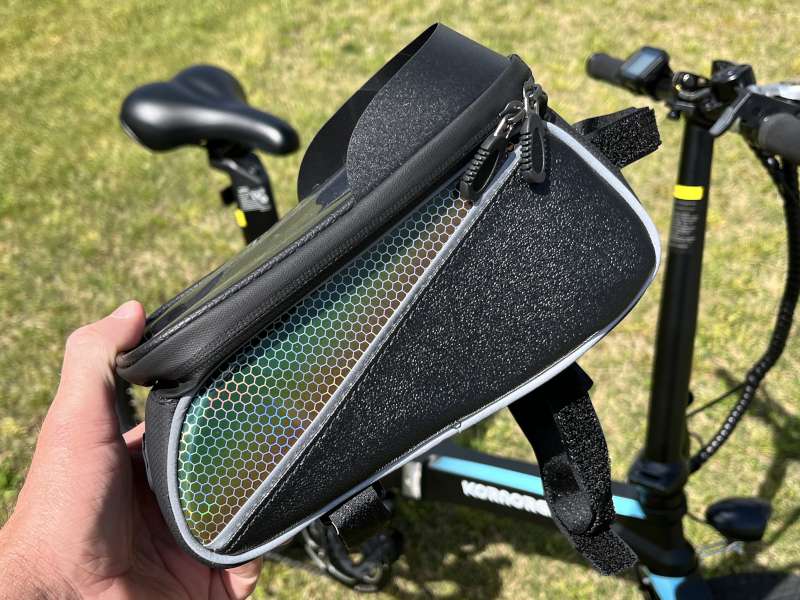
Kornorge included a small saddle bag, one designed to hold my cell phone in place so that I can look at it while biking without having to hold it. This could be really handy if I was using Apple Maps to navigate to an unfamiliar part of town. Sadly, this bag doesn’t fit anywhere on this bike. The straps are too small to secure it to the down tube, and I couldn’t see the phone if I secured it to the handle bar stem or to the seat tube. It’s like someone at Kornorge decided to throw in the bag without first checking to see if it would actually fit well on the bike. Again, I get the sense that Kornorge isn’t really paying attention to what they are doing.
At this point, the Kornorge A9 electric bike is assembled. We just need to turn it on and go for a ride.
Performance
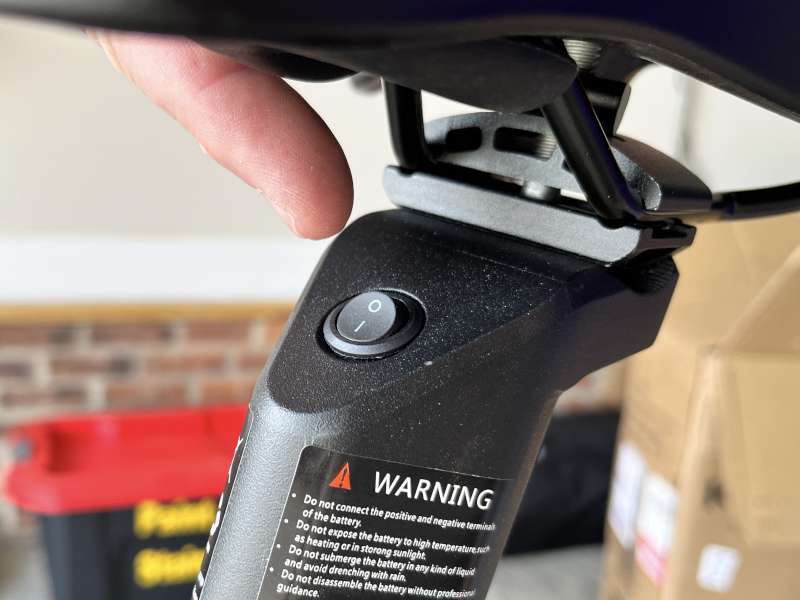
When I’m ready to ride, I first turn the power on using a small switch found under the seat.
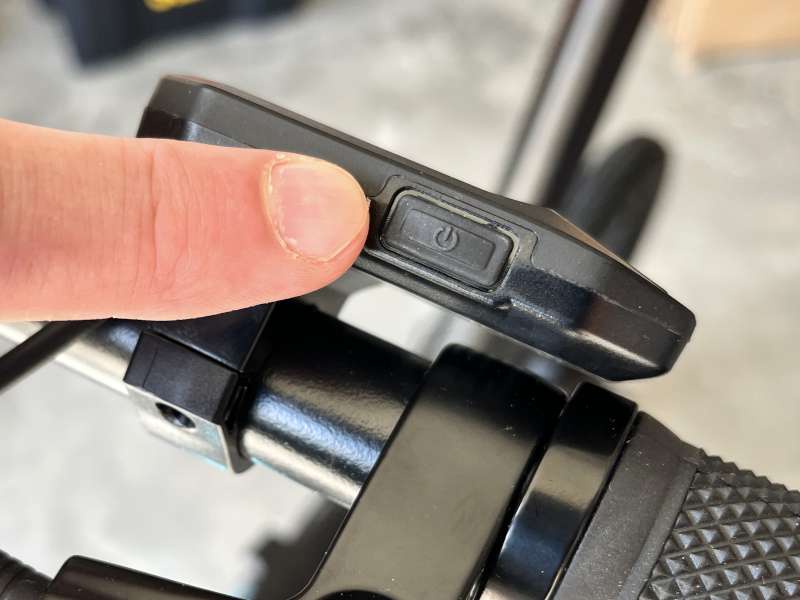
Then I press the button on the top of the display for three seconds. The display turns on and the bike is ready.
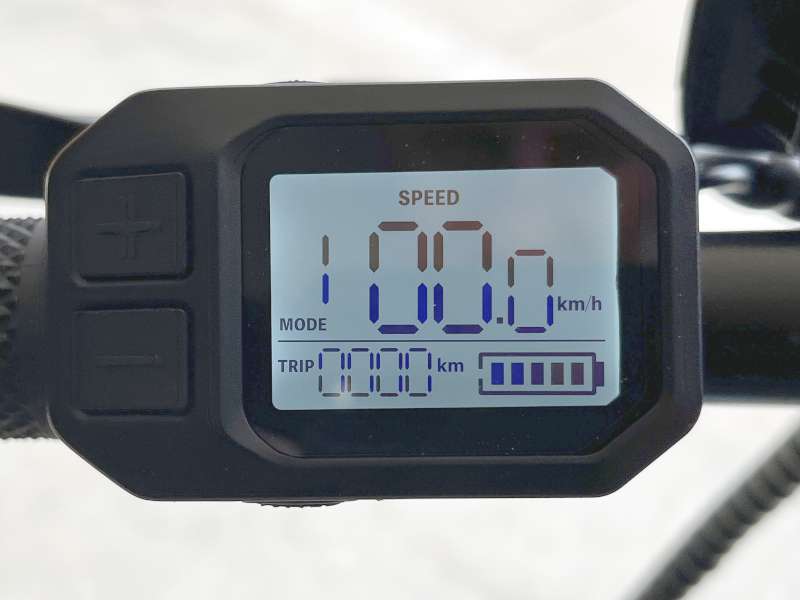
The display is simple but effective, showing the power assist system (PAS) level, the speed, the odometer, and the battery level. It can change between MPH and KMH and between trip and total odometer, and the display brightness can be adjusted.
The Kornorge A9 has three different biking modes: manual, pure electric, and pedal assist. In manual mode, I am riding the bike as if it were a normal bike. I set the PAS to 0, and then I pedal and shift gears just like any other bike. This works very well for a couple of reasons. One, this bike is fairly light. It’s a reasonably svelte 41 pounds, no doubt due to its magnesium alloy frame and small tires. Two, the gear shift is designed such that the first three gears are very, very low; that is, the ring diameters of the first three gears are very similar. While this would be annoying on a road bike, it’s ok for an urban bike that’s riding on crowded streets and sidewalks. This is also a bonus feature for this bike, because if my son ever runs the battery down, he can still get around on the bike. The problem with these gears is that they are not ok for an ebike, especially one like the A9 that only has three levels of PAS.
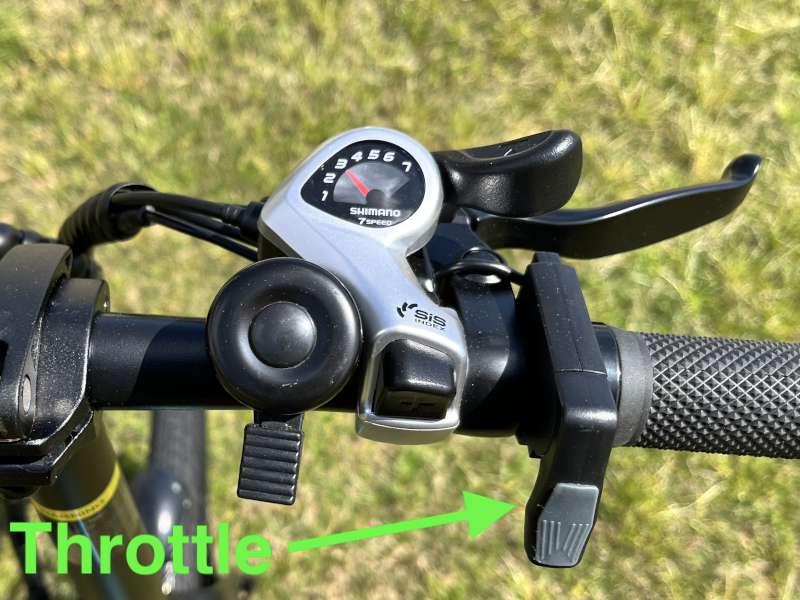
In pure electric mode, I set the PAS to 1, 2, or 3, press the throttle, and the bike powers itself. It will go about 9, 12, or 15 MPH respectively. The PAS has a pretty significant delay, about a second, both when pressing and releasing the throttle. Though the delay is annoying, this mode of travel works great. I can see this being a big help when my son is tired, or when he’s riding down a road or sidewalk with no pedestrians and he’s just ready to max things out.
In pedal assist, the mode most commonly used on an ebike, the motor works with my pedaling to cooperatively power the bike. The problem is that these two don’t cooperate very well at all on the A9. It’s as if there were two engineers at Kornorge, one who designed the gear shifting system, and another who designed the electric system, but the two never ensured that their systems work nicely together. In pedal assist mode, the PAS always pushes the bike to 12 MPH, whether I set it to PAS level 1, 2, or 3. I’m pretty sure this is a bug because I would expect it to be slowest on 1 and fastest on 3. I start the bike in first gear, and after a one-second delay, the motor kicks in and begins accelerating the bike to 12 MPH. Because the gears are set so low, I immediately find myself spinning. I start shifting gears, but it’s not until I get all the way to 6th gear before my pedaling returns to a normal cadence. The engineers at Kornorge failed to design the A9 so that the speed of the PAS matches the cadence of the gears. It’s insanely awkward and very frustrating to use the bike in pedal assist mode. To make it worse, when I shift into the highest gear, gear 7, the PAS stops working altogether. When I tested and road the VANPOWERS Manidae, I never experienced these issues. The PAS and the gears were so perfectly matched that it just worked. The first time I rode the Manidae on a trail, I was literally laughing out loud in joy at how fun the bike was to ride. The A9 doesn’t bring that kind of joy at all in pedal assist mode. The PAS only works effectively while I am in 6th gear.
After a lot of experimenting, the best way I could find to use the Kornorge A9 ebike is like this: Always start in first gear with the PAS turned off. Shift gears until I hit 6th gear, then turn on the PAS and keep pedaling. This allows me to comfortably cruise at around 12 MPH but not faster; that’s not very fast for an ebike, but it’s probably fast enough in town. If I really want to go faster, I set the PAS to 3, press the throttle, and stop pedaling; now I’m skimming along at 15 MPH. In other words, the A9 only works well when I switch between modes at the exact right time and gear. It’s not cool. Kornorge needs to completely redesign the gears and the PAS. They need to add more levels for the PAS—it should have at least five—and they need to scale the gear ratios up so that they work comfortably all the way to the max speed of the bike.
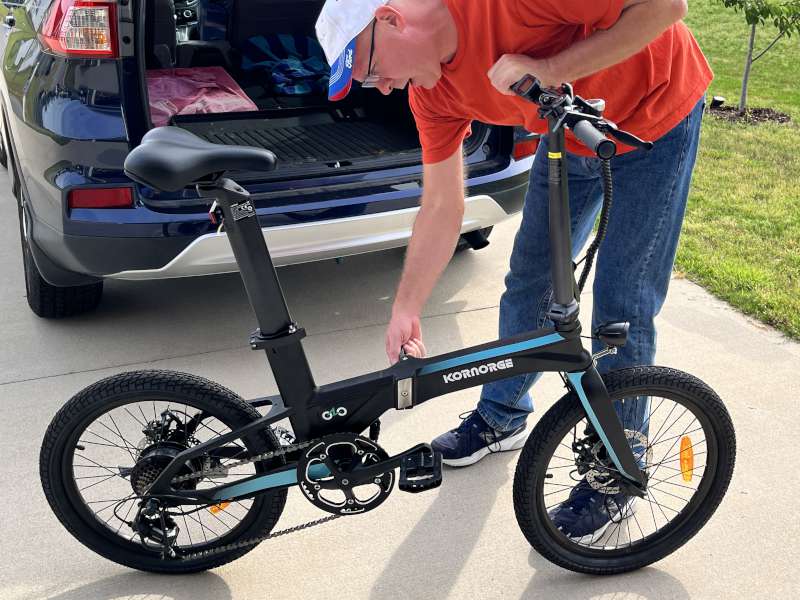
The bike collapses in two places, where the handle bar stem meets the down tube and in the middle of the down tube.
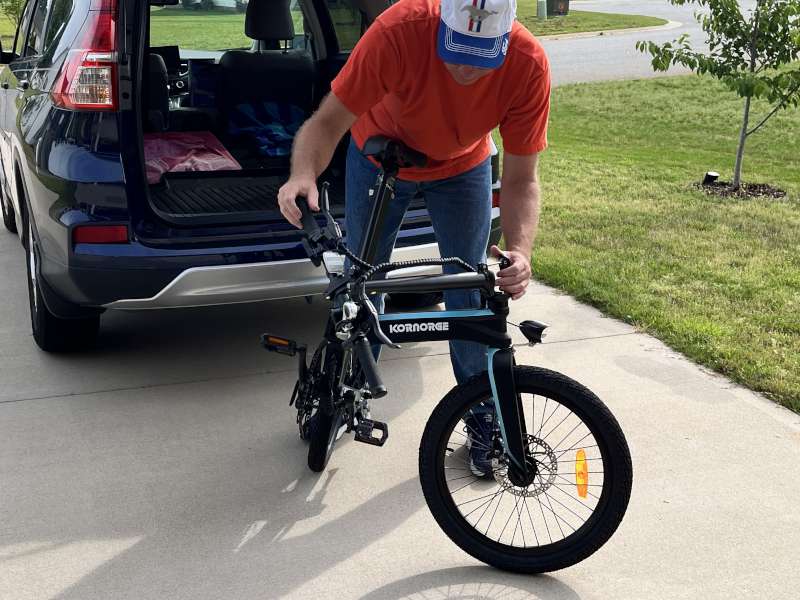
Both use quick release levers to make it easy to both release and to lock up again.
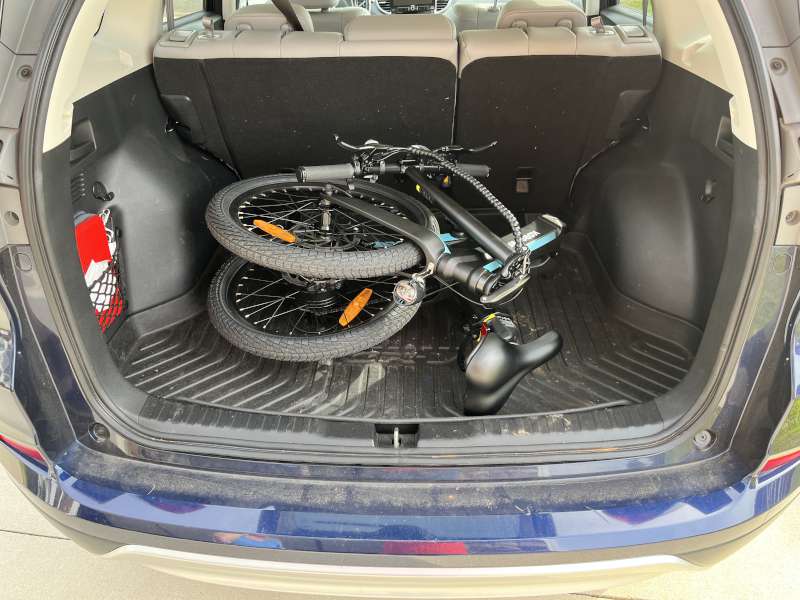
The bike fits into a reasonably small space due to these releases and due to the smaller wheel size. When folded up, I measured the A9 to be about 35x30x18 inches, which is amazingly small, and it easily fits into the back of my Honda CR-V with lots of room to spare.
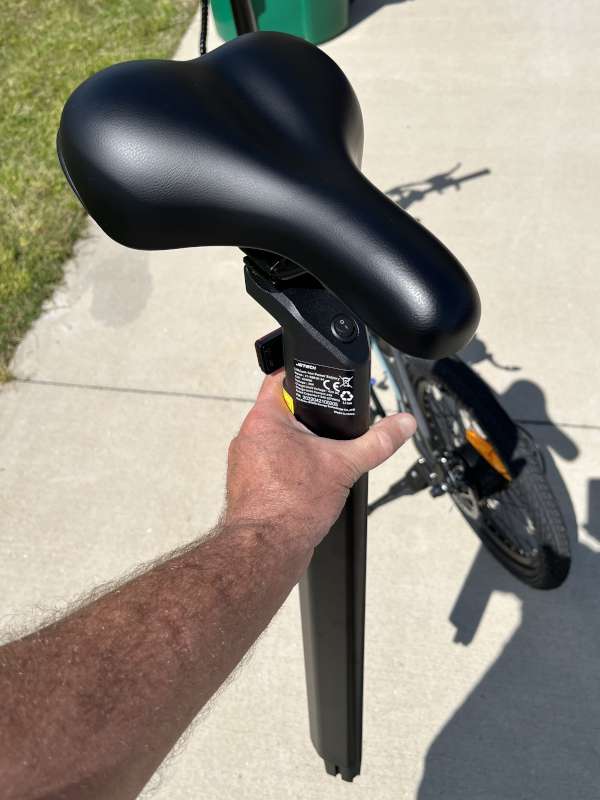
The battery on this bike reflects its urban commute bike nature. The battery has a relatively short range (25 miles) and slow max speed (15 mph).
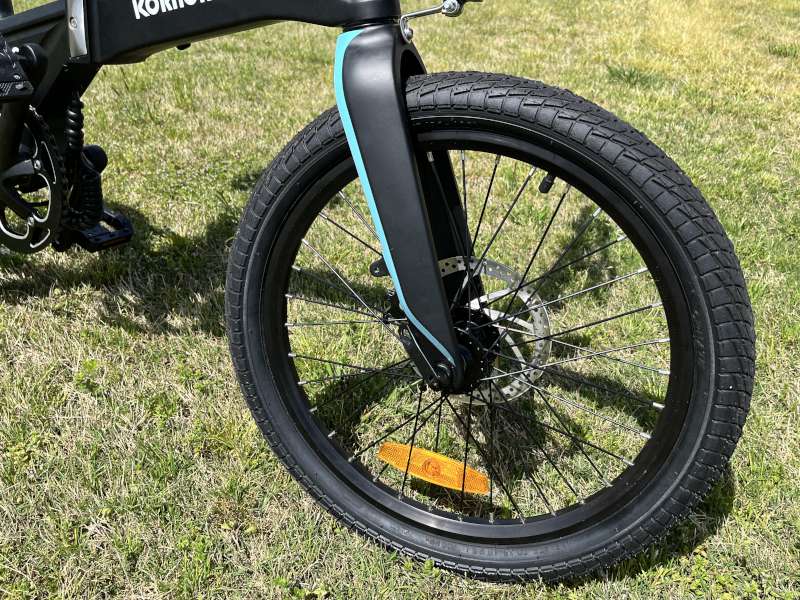
The Kornorge A9 has small, 20-inch tires. This size is good because it makes the entire bike smaller and thus easier to fold up and fit into a small space. It’s bad because my son will feel the bumps and potholes more, especially since there are no shocks on the bike.
Extra Features
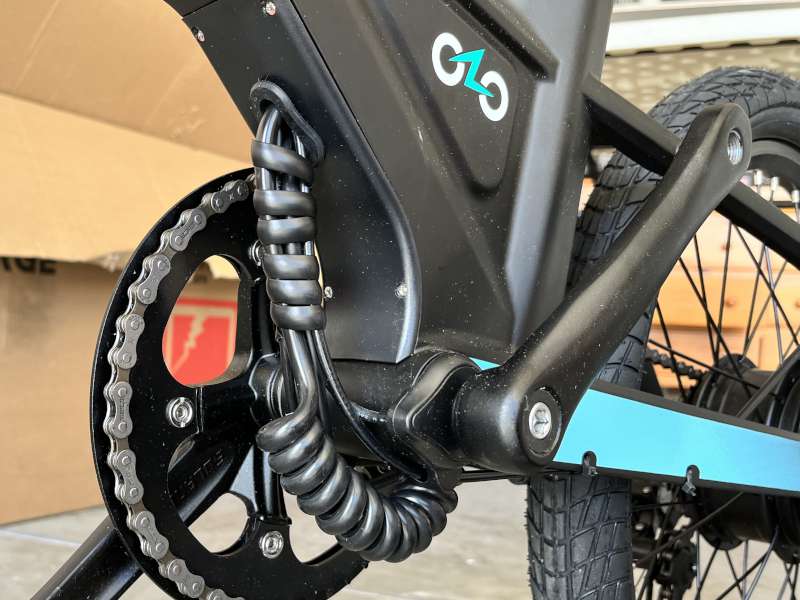
The A9 has interior cabling for most of the bike, which is really nice. Some wires are exposed at the bottom of the bike, as this is where the power cable plugs into the battery.
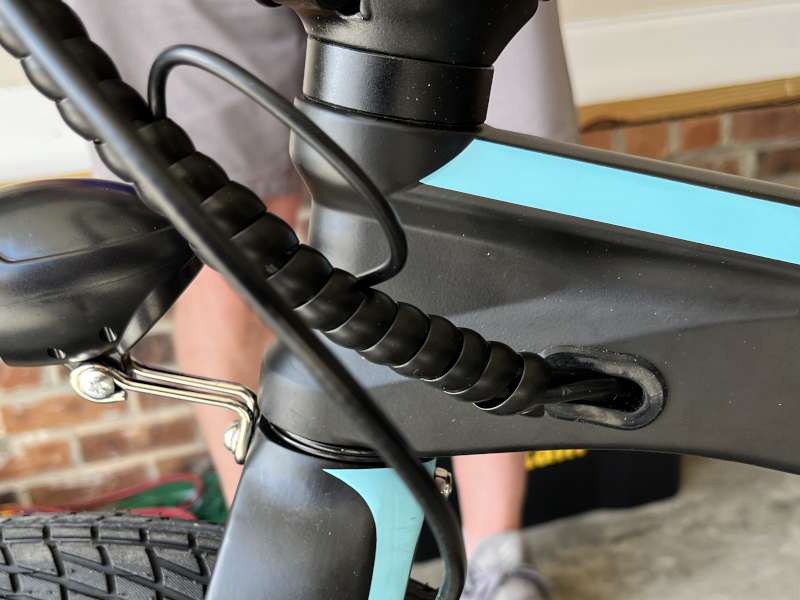
Other wires are exposed from the handle bar to the down tube. Everything else is neatly tucked away. This design works great for an urban bike.
The A9 has both a head light and a tail light, and they are turned on by pressing the button underneath the display. The rear light flashes when braking. The lights are bright, sufficiently so for me to ride around my suburban neighborhood at night. If I was going to be riding in a more urban area with cars, I would want even more light, perhaps from a headlamp.
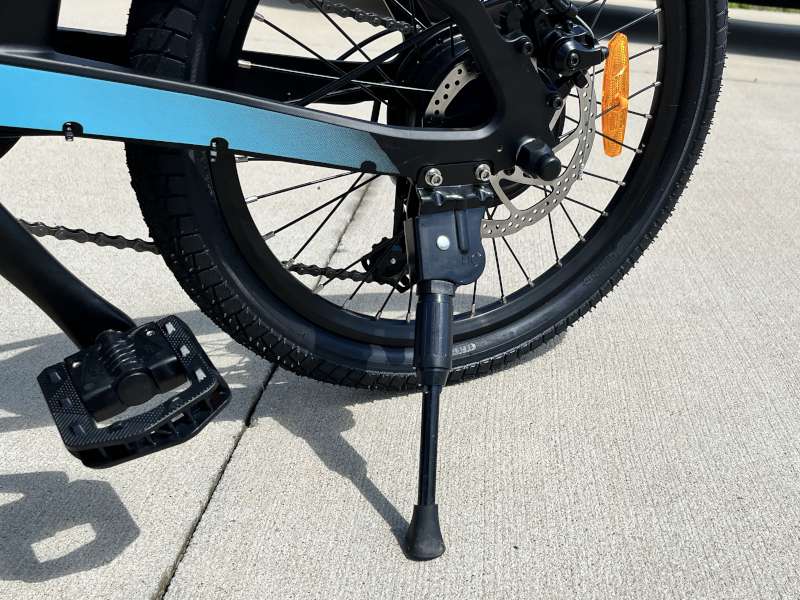
The A9 has a small but sturdy kickstand on the rear of the bike, and it does a great job holding the bike up.
What I like
- Collapsible into a small space
- Sturdy yet light
- Attractive yet practical design
What I’d change
- Throw away this manual and write a good one
- Redesign the gears and the PAS so that they work smoothly together
- Include all the tools necessary to assemble the bike (but no extras)
- Redesign the battery so that it’s not plugged in at the bottom of the bike
- Include a saddle bag that is actually designed for this bike
Final thoughts
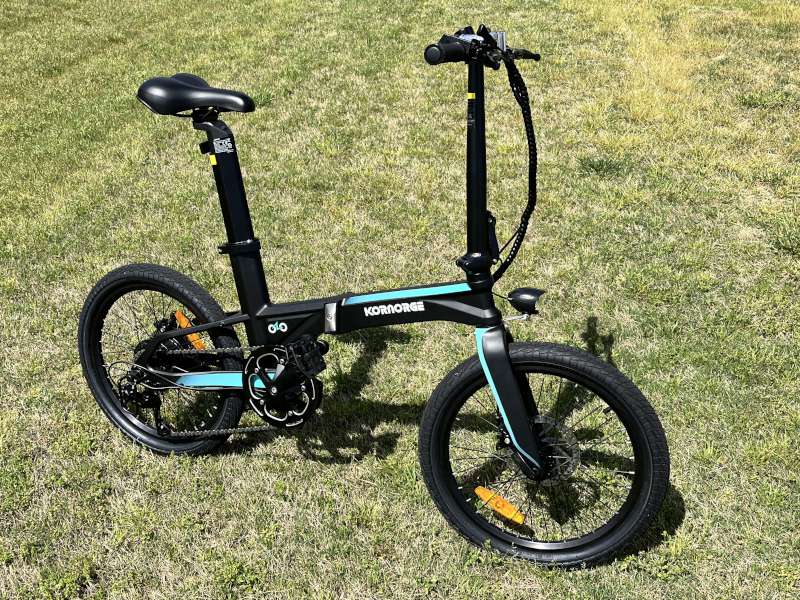
The Kornorge A9 is a collapsible ebike designed for urban commutes. The battery built into the down tube can help propel it to 15 MPH and keep it cruising for 25 miles. Unfortunately, Kornorge has been careless in a number of areas, so I cannot recommend this bike to you. The manual is missing lots of key information required to assemble the bike. Some of the required tools were included in the box but others were missing. The included saddle bag doesn’t fit anywhere. While the bike works great in manual mode and pure electric mode, it does not work well at all in pedal assist mode, which is the normal way to use an ebike. While I think it’s possible to get some good mileage out of this bike, if my son can figure out the right combination of modes for where he travels, he shouldn’t have to figure things out. The bike should just work smoothly, especially in pedal assist mode. Kornorge needs to take this one back to the drawing board and redesign the PAS so that it works better with the gears.
Price: $699.99
Where to buy: Kornorge’s online store and Amazon
Source: The sample for this review was provided by Kornorge

![[Ultra-Secure] With our uniquely designed bike phone holder mount, whether navigating bumpy roads or high-speed roads, your phone remains securely fastened to the handlebar. Its all-round shape firmly secures each corner of your phone, providing exce...](https://m.media-amazon.com/images/I/41f8iCmkMsL._SL160_.jpg)

Gadgeteer Comment Policy - Please read before commenting
Great and in-depth review. Great comments about the padel-assistance feature that is VERY confusing for many e-bike users. Have you heard back from the manufacturer to see if they have updated their software to improve this feature? Aside from this issue, this e-bike seems well-built and priced properly.
Thanks for the idea, Jin. No, we did not hear back from KORNORGE, and there’s no way to update the software on this bike. It doesn’t have Wi-Fi, a mobile app, an SD card slot, or anything that could be used for this purpose.
I was considering this bike, and I worried about the long-term reliability of that very unique battery in the seat tube. Ho Given you have had it for a while now, how reliable do you think it is going to be? Mu use will probably be a fair-weather bike to take camping trips, so I’m not too worried about “rain,” though puddles may be an issue. But I am more worried about physical strength issues since if that fails, there is no easy replacement.
Also, on the PAS, after more experience, did your son eventually find it useful in different settings? I would have at least expected different PAS levels to behave differently since they do different speeds on the throttle.
In terms of shifting with a weak PAS system on my other hub-drive, my normal behavior is to leave it in a higher gear and use the throttle to accelerate up to speed as I pedal hard in the beginning. But I really want different PAS levels of effort (or at a minim different PAS=speed when pedaling. If that works then the PAS may be usable to us. I use lower gears on hills with PAS/ and gears when not in ebike mode but really want the exercise most of the time.
The A9 is designed for short-range commutes in town. If you’re going hiking, I would either get a mountain bike or a fat-tire trail bike.
As for the PAS, no, we never really found a better setting. It’s just awkward.
I’ve owned four folding bikes over the years. They all had 20″ tires; only one had multiple gears; none had a motor. One thing I’ve learned: a portable bike can’t be too heavy to portage. That’s why I bought the A9. It’s under 35 pounds with the battery out, so I can load it in my trunk without looking like an uncoordinated weakling.
Because it doesn’t have to accomodate a bulky battery in or on the downtube, the frame is slender and un-electric looking. It’s a stealth e-bike. And the magnesium castings are…wonderful.
The comfortable-looking seat that came with the A9 isn’t. The oddly angled seat rails prevent proper levelling adjustment on the inadequately angled seat tube clamp. No big deal, but if you can’t get comfy, you’ll need a different seat.
My odometer/trip odometer does not remember miles when I power the bike off. You read that right: the odos don’t remember miles travelled. And because the battery level meter is a little bit crazy, it’s kinda impossible to know how many of that massive 25 mile range is left.
So while the PAS is flawed, the bike is slow, range is short and the odos are worthless, the A9 is light, looks good and actually goes forward (stealthfully) under its own power. Not bad. Not too bad at all.